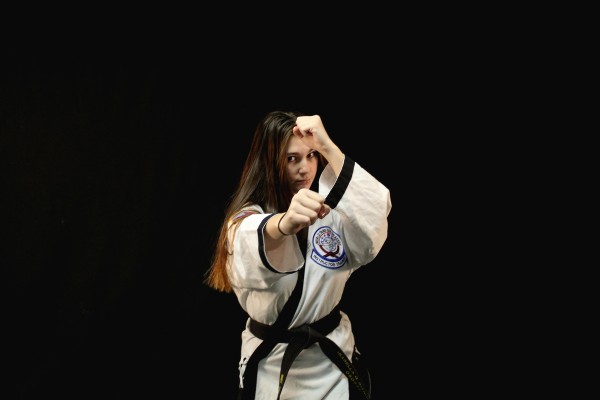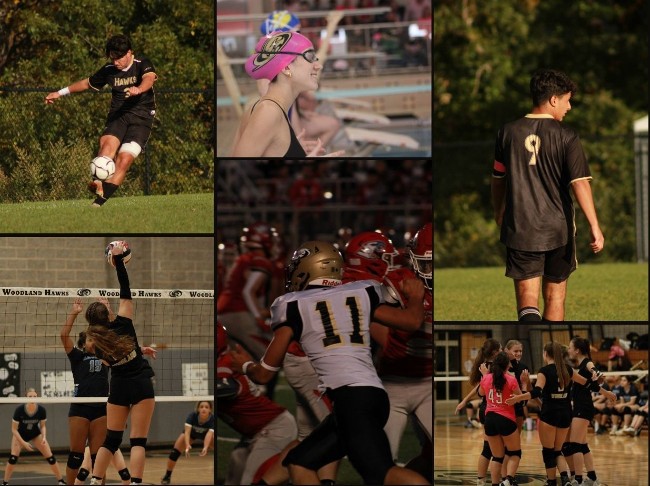Isabella Bianchini was in third grade when she began Tang Soo Do, a Korean martial art similar to karate. But during that first class, she had no idea how much of an impact the martial art would have on her life.
There are over one hundred and seventy different forms of martial arts in the world. In the United States, Karate, Taekwondo, and Tang Soo Do are all popular types of martial arts. They each display various kinds of techniques and skill-sets, all of them unique to its’ own specific martial art.
Bianchini says that she specifically chose Tang Soo Do because it was a way of self-defense, rather than a method of attack.
“You look at styles of martial arts like Judo and Taekwondo, and they’re more violent,” Bianchini says. “Tang Soo Do offered a peaceful way where I could learn how to purely defend myself, and I thought that being able to use it for that reason rather than purposely inflicting harm was important.”
Bianchini, a freshman at Woodland, has been taking martial arts classes since she was seven. She currently spends six days a week practicing Tang Soo Do and teaching younger students how to defend themselves at her instructor’s studio in Prospect. But Bianchini faced many obstacles before she could get where she is today.
Bianchini was a first-degree blackbelt in seventh grade when her martial arts studio, Prospect Karate, unexpectedly shut down. After its’ closing, all of the students from Prospect Karate were transferred to Prospect Martial Arts, another local studio. Although the names may sound similar, the two studios were completely different from each other. Prospect Martial Arts was a part of the World Tang Soo Do Association, while Prospect Karate was not.
The World Tang Soo Do Association (WTSDA), created to preserve the original integrity of the martial art, hosts many different championships and competitions around the world. The organization requires studios to teach using certain methods. A studio that is not affiliated with the WTSDA would have very different ways of teaching than one with relations to the WTSDA. This meant that Bianchini had to completely relearn many of the concepts that she had been taught at Prospect Karate.
“I even took a break during the switch between studios,” Bianchini says, admitting that her original intention during the break had been to quit. “But I ended up rejoining after about a month or two because I missed it.”
Bianchini definitely reaped the rewards upon returning to the studio. Almost a year after her break, she tested to get her second degree blackbelt.
The test, a two-part exam with a written section that included 100 questions, was no easy feat. A score of 80% on the written test was required in order to qualify for the physical portion. It required strenuous mental preparation, in addition to the conditioning needed to pass the physical portion. The test’s physical portion consisted of three parts: sparring, forms, and breaking.
Bianchini spent months poring over the Korean Martial Arts Tang Soo Do Black Belt Manual, a 400-page book composed entirely in Korean, in order to master all of the terms, rules, and history behind Tang Soo Do. On top of this, she spent hours in the studio practicing her forms and physical skills for the test. This took away from her time with friends and family.
“No matter where she was, Bella was always reading her karate book,”
said Alyssa Gillies, a close friend of Bianchini. “Sometimes she would eat lunch while reading, and she would miss out on quality conversations on the bus because she was so focused.”
In late June of this year, Bianchini attended a black belt camp at Post University. There, she took the written portion of the test for the first time and scored a 79, which was just one point short of passing. Two months later she retook the test and this time earned a 95. Bianchini scored the highest out of all her fellow second-degree blackbelts, and exceeded the required score to pass the test by fifteen points.
A large part of being a member of the Tang Soo Do community is participating in competitions. Bianchini has been taking part in competitions since she was in eighth grade, and a lot goes into competing.
First, Bianchini pre-registers for the competition through her studio. On the day of, she arrives half an hour before start time to warm up. Once the event starts, the coordinators organize competitors into divisions based on age and rank. Then, Bianchini presents her forms in front of three judges, who score her based on a number of different factors. After forms, she does weapons, in which she usually competes with her bow-staff. Then she spars against other people from her division. If she is competing in a championship, as opposed to an open tournament, she will break boards last.
The first time that Bianchini ever placed in a competition was in November 2018. She ranked third in her division of fifteen girls for sparring and earned a bronze medal.
Since then, she has come a long way in terms of competing. Now, Bianchini participates in one to two competitions per month. Recently, she took part in the 26th Fall Tang Soo So Classic Championship. She placed first for forms, first for weapons, and third overall, making it her best performance yet.
Currently, Bianchini is focused on living in the present instead of wondering what is ahead for her. Her main priority is helping the people who assisted her in making so many huge milestones this past year.
“Right now, I don’t really have a goal for myself,” Bianchini said. “A lot of people have helped me get to where I am now: people in my studio, my friends, most importantly my family, and so now it’s my turn to give back to them.”



















